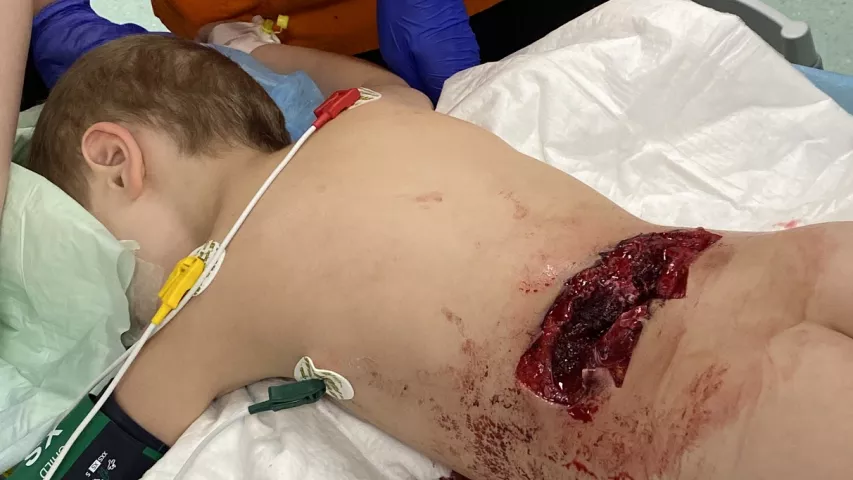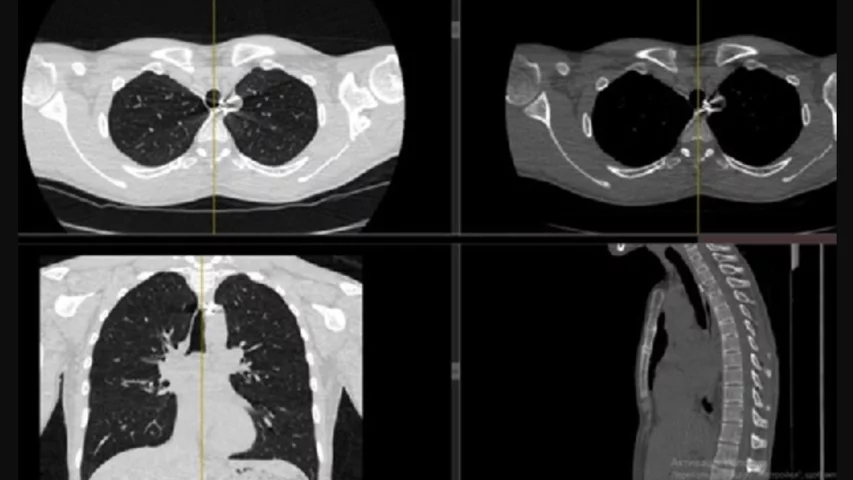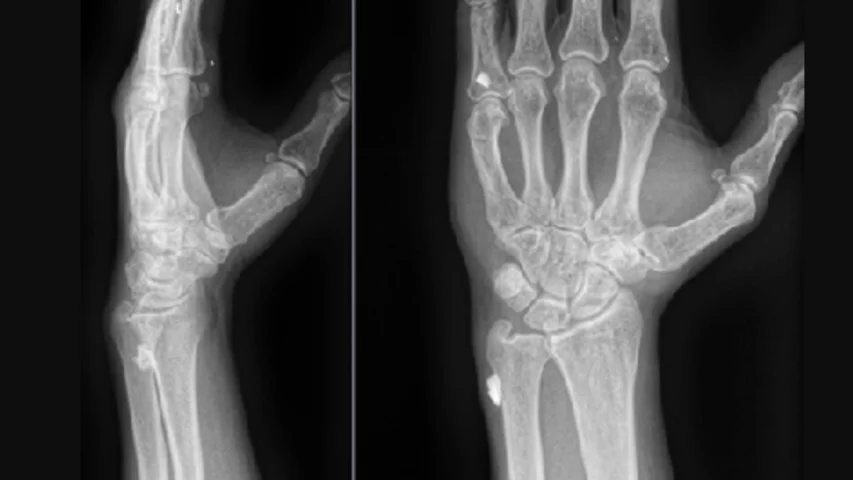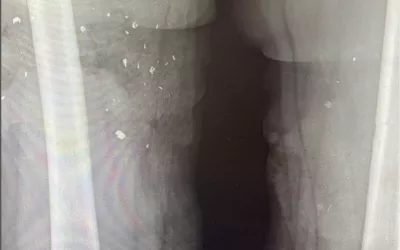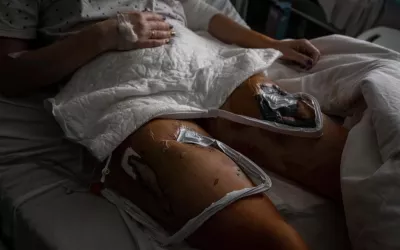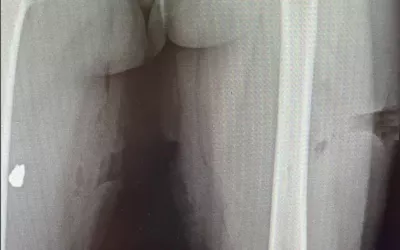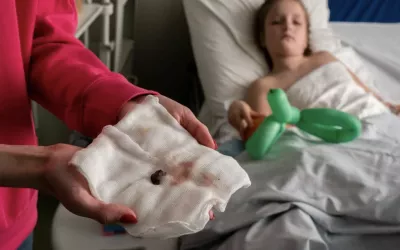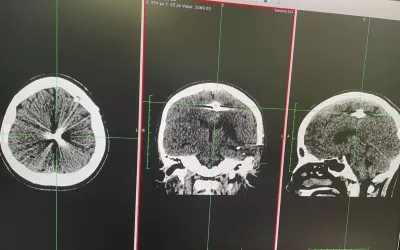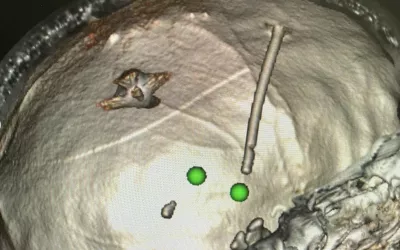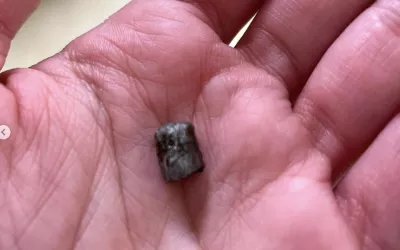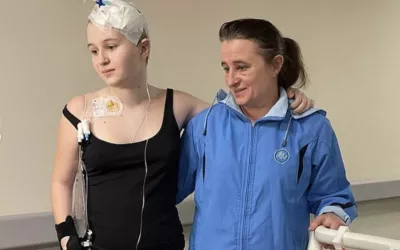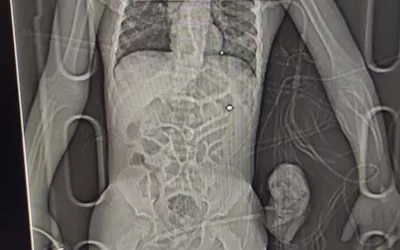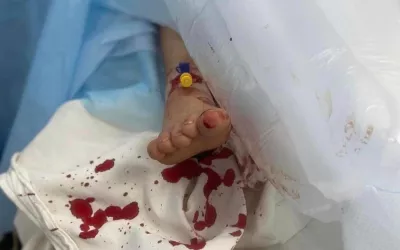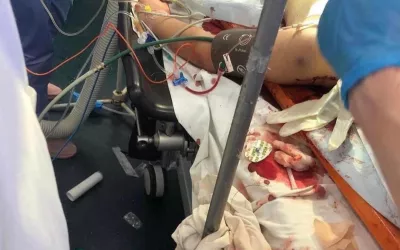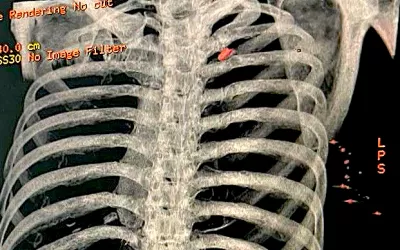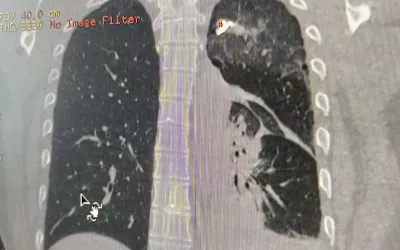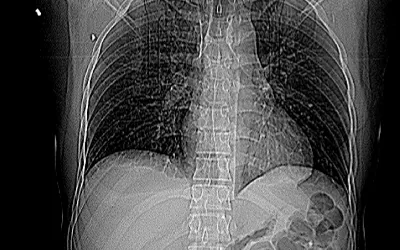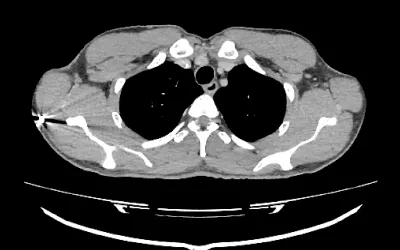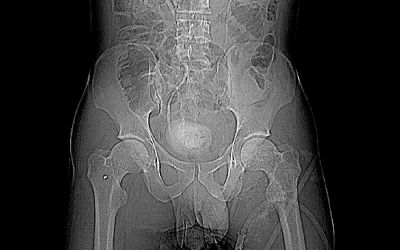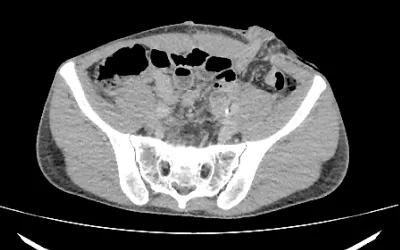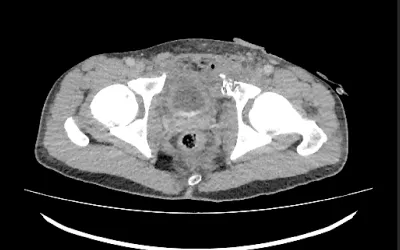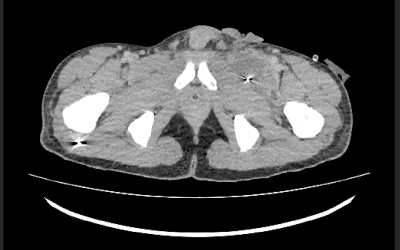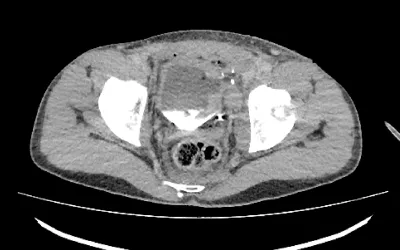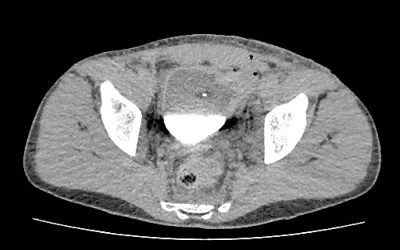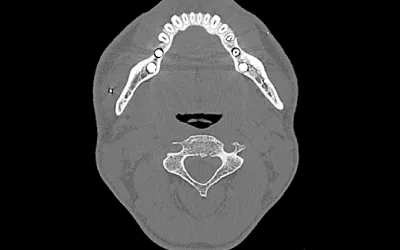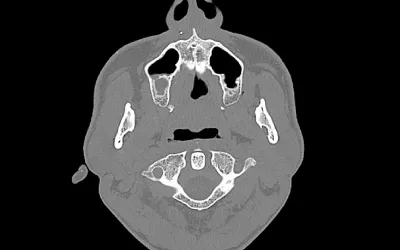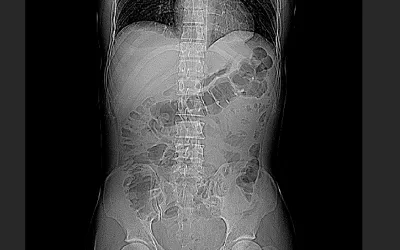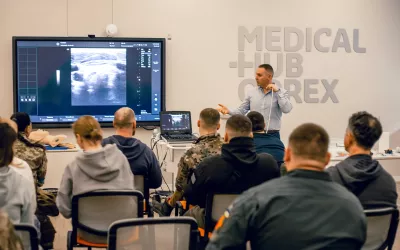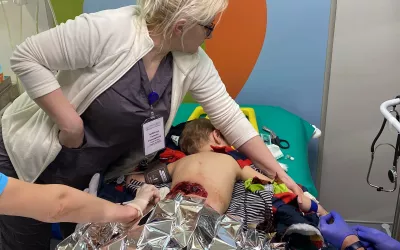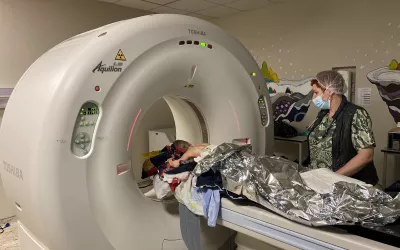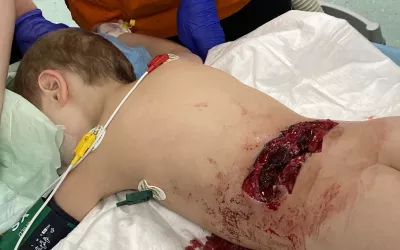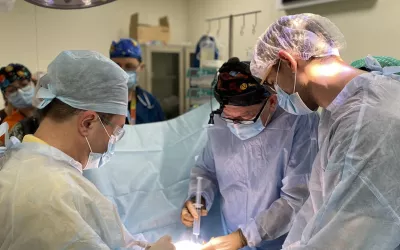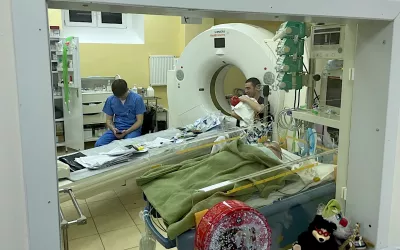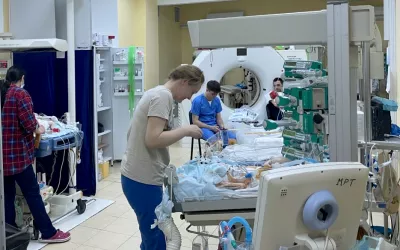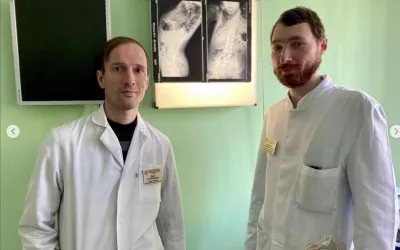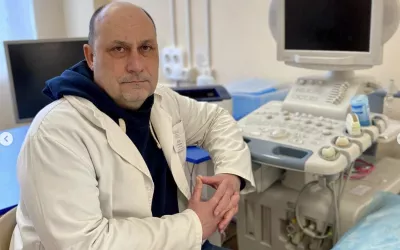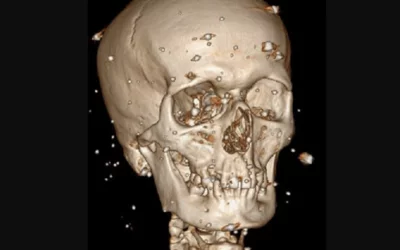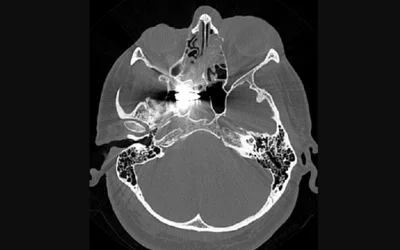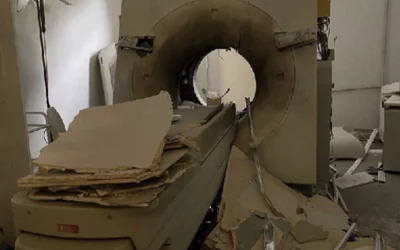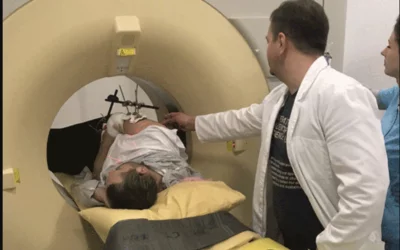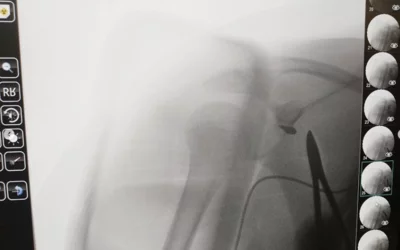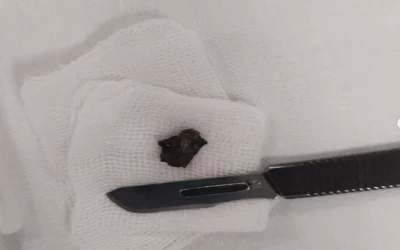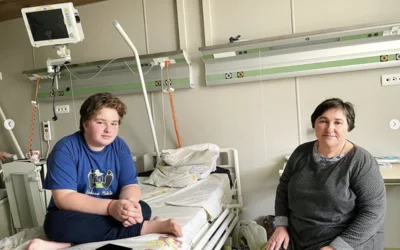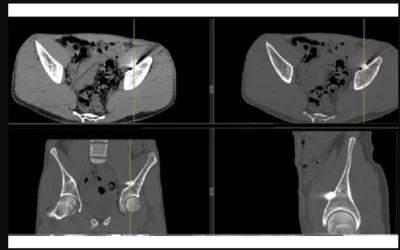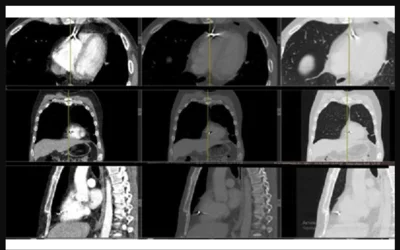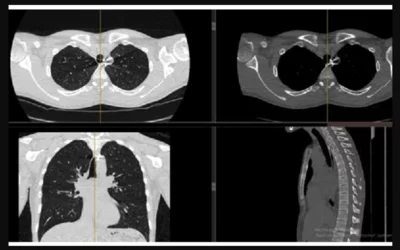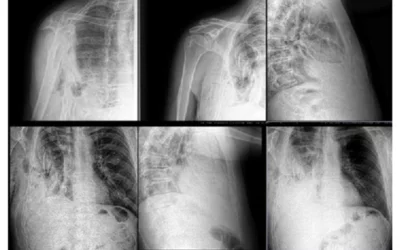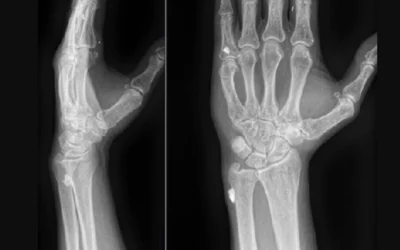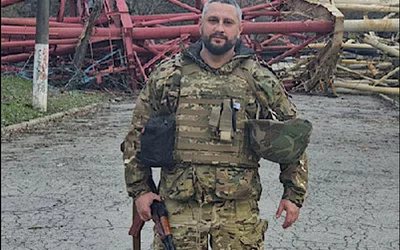PHOTO GALLERY: Radiology images of Ukrainian trauma patients wounded in war
This is medical imaging from hospitals in Ukraine showing the impact of the Russian invasion on patient care and the involvement of radiology. The images all show wounds inflicted by Russian bullets or shrapnel, and the gallery includes pediatric as well as adult patients. This educational offering will be updated as we receive new radiology images. Cases can be submitted to Dfornell@innovatehealthcare.com.
Read the related article, Radiologists in Ukraine helping the war effort as Russia continues to attack
X-ray radiograph showing numerous steel fragments in adult female patient Natalia from Russian mortar shrapnel, after a round exploded 10 meters from the car she was in. Okhmatdit Children's Hospital in Kyiv treated her and her and her 7-year-old daughter Varya, also wounded in the legs. Both had severe damage to the soft tissues of the thighs. Both underwent surgery to remove shrapnel fragments. Natalia had a piece of glass stuck in her hand, but it is very risky to extract so it was left in place. The family decided to evacuate the Kyiv suburb of Irpin as the Russians began to surround the city. The relatives drove to the Russian checkpoint in two cars and Russian soldiers began firing mortars at the civilians.
Adult female patient Natalia and her 7-year-old daughter Varya suffered severe mortar shrapnel wounds, after a round exploded 10 meters from the car they were in. Okhmatdit Children's Hospital in Kyiv treated them. Both had severe damage to the soft tissues of the thighs. Both underwent surgery to remove shrapnel fragments. Natalia had a piece of glass stuck in her hand, but it is very risky to extract so it was left in place. The family decided to evacuate the Kyiv suburb of Irpin as the Russians began to surround the city. The relatives drove to the Russian checkpoint in two cars and Russian soldiers began firing mortars at the civilians.
X-ray showing a chunk of Russian mortar shrapnel in the right thigh after first entering and exiting the left thigh of female pediatric patient Varya, age 7. The fragment that was surgically removed from her leg. The family waited a few days and decided it was time to evacuate the Kyiv suburb of Irpin as the Russians began to surround the city. The relatives drove to a Russian checkpoint in two cars and Russian soldiers began firing mortars at the cars. A round exploded 10 meters from the car containing the Varya and her mother Natalia. Okhmatdit children's hospital in Kyiv diagnosed severe damage to the soft tissues of the thighs of both mother and daughter in the mother and daughter.
Varya, age 7, with Russian mortar shrapnel fragment that was surgically removed from her leg. It had pierced both legs. The family waited a few days and decided it was time to evacuate the Kyiv suburb of Irpin as the Russians began to surround the city. The relatives drove to the Russian checkpoint in two cars and Russian soldiers began firing mortars at the cars. A round exploded 10 meters from the car containing the Varya and her mother Natalia. Okhmatdit's specialists diagnosed severe damage to the soft tissues of the thighs in the mother and daughter.
Brain CT scan showing shrapnel in between the hemispheres of the brain after entering fron front temple in Sofia, age 13, from the Mykolaiv region, located along the Black Sea coast between Kherson and Odesa. She was struck in the head by shrapnel from a Russian rocket artillery bombardment of her village March 5. Sonya and her mother were tapping the windows to protect themselves from broken glass caused by the shock waves after an explosion. She said she heard the whistle of a rocket and managed to take three steps away from the window when a piece of metal hit her in the temple. She fell to the ground and lost consciousness. She was taken to a local hospital in Mykolaiv. Despite the constant shelling, the local doctors performed surgery, but were unable to retrieve the shrapnel. She was placed under heavy sedation for 4 weeks due to severe headache pain. She could barely move the right side of her body. Moved to Ohmatdyt children's hospital in Kyiv March 29 to remove the fragment. The shrapnel. Trepanation of the skull performed to removed the fragment with the help of ultrasound. After surgery the 7th grader said her headache was gone. Underwent rehabilitation.
Ultrasound guidance was used to retrieve the shrapnel fragment from the brain, located in between the hemispheres of the brain after entering the front temple in Sofia, age 13. Ohmatdyt children's hospital in Kyiv removed the fragment. Trepanation of the skull performed to removed the fragment with the help of ultrasound. She was struck in the head by shrapnel from a Russian rocket artillery bombardment of her village March 5. Sonya and her mother were tapping the windows to protect themselves from broken glass caused by the shock waves after an explosion. She said she heard the whistle of a rocket and managed to take three steps away from the window when a piece of metal hit her in the temple. She fell to the ground and lost consciousness. She was taken to a local hospital in Mykolaiv. Despite the constant shelling, the local doctors performed surgery, but were unable to retrieve the shrapnel. She was placed under heavy sedation for 4 weeks due to severe headache pain. She could barely move the right side of her body.
Russian rocket artillery shrapnel removed from the center of the brain of Sofia, age 13, from the Mykolaiv region, located along the Black Sea coast between Kherson and Odesa. She was struck in the head in her home during a rocket artillery bombardment of her village March 5. She was taken to a local hospital in Mykolaiv. Despite the constant shelling, the local doctors performed surgery, but were unable to retrieve the shrapnel. She was placed under heavy sedation for 4 weeks due to severe headache pain. She could barely move the right side of her body. Moved to Ohmatdyt children's hospital in Kyiv March 29 to remove the fragment. The shrapnel was stuck in between the hemispheres of the brain when imaged on CT. Trepanation of the skull performed to removed the fragment with the help of ultrasound guidance. After surgery the 7th grader said her headache was gone. Underwent rehabilitation.
Sofia, age 13, Mykolaiv region, located along the Black Sea coast between Kherson and Odesa, was struck in the head by shrapnel from a Russian rocket artillery bombardment of her village March 5. Sonya and her mother were tapping the windows to protect themselves from broken glass caused by the shock waves after an explosion. She said she heard the whistle of a rocket and managed to take three steps away from the window when a piece of metal hit her in the temple. She fell to the ground and lost consciousness. She was taken to a local hospital in Mykolaiv. Despite the constant shelling, the local doctors performed surgery, but were unable to retrieve the shrapnel. She was placed under heavy sedation for 4 weeks due to severe headache pain. She could barely move the right side of her body. Moved to Ohmatdyt children's hospital in Kyiv March 29 to remove the fragment. The shrapnel was stuck in between the hemispheres of the brain. Trepanation of the skull performed to removed the fragment with the help of ultrasound. After surgery the 7th grader said her headache was gone. Underwent rehabilitation.
Digital X-ray of a boy from Kyiv area who was shot during the Russian advance on the city. Wounded on his side and neck and had a concussion. In the intensive care at Ohmatdyt pediatric hospital intensive care unity in Kyiv Feb. 27, 2022. The military called an ambulance, and doctors performed an emergency surgery. Photo courtesy of Ohmatdyt.
Boy from Kyiv area who was shot during the Russian advance on the city. Wounded on his side and neck and had a concussion. In the intensive care at Ohmatdyt pediatric hospital intensive care unity in Kyiv Feb. 27, 2022. The military called an ambulance, and doctors performed an emergency surgery. Photo by Ohmatdyt
Boy from Kyiv area who was shot during the Russian advance on the city. Wounded on his side and neck and had a concussion. In the intensive care at Ohmatdyt pediatric hospital intensive care unity in Kyiv Feb. 27, 2022. The military called an ambulance, and doctors performed an emergency surgery. Photo by Omatdyt
A 3D CT image reconstruction showing a Russian bullet in a civilian patient's upper lung lobe. The entry point and track of the bullet can be seen can be seen on the right of the image, marked by a series of metal fragments. The patient was being treated at the Heart Institute in Kyiv after he tried to drive his family out of the area of the front lines and was shot by Russian soldiers. Read more about this case. Photo by Igor Mokryk, MD.
A chest CT image showing a Russian bullet in a civilian patient's upper lung lobe. Bullet entered from his left side. The patient was being treated at the Heart Institute in Kyiv after he tried to drive his family out of the area of the front lines and was shot by Russian soldiers. Read more about this case. Photo by Igor Mokryk, MD.
Scout CT scan showing two pieces of shrapnel fragments on left side of the image, under the arm. This is a foreign soldier who volunteered to fight for Ukraine, wounded in combat at Nikolayv. Multiple fragments of shrapnel penetrated the abdomen and fractured the pelvis. Laporotomy performed, resulting in bowel resection and bladder stoma, to divert urine out of a port in the abdomen. Chest and head CT also performed to assess shrapnel wounds in the chest and face. One large metal fragment seen subcutaneous on the chest CT. At least 5 small superficial shrapnel fragments identified in a head CT scan, which was performed to assess the location of the metal fragments and if there was any internal damage. Image from Odrex Hospital, Odesa.
Shrapnel fragment on left side of the image with metal blooming artifact. This is a foreign soldier who volunteered to fight for Ukraine, wounded in combat at Nikolayv. Multiple fragments of shrapnel penetrated the abdomen and fractured the pelvis. Laporotomy performed, resulting in bowel resection and bladder stoma. Chest and head CT also performed to assess shrapnel wounds in the chest and face. One large metal fragment seen subcutaneous on the chest CT. At least 5 small superficial shrapnel fragments identified in a head CT scan, which was performed to assess the location of the metal fragments and if there was any internal damage. Image from Odrex Hospital, Odesa.
Scout CT scan of pelvis and abdomen showing small pieces of shrapnel fragments. This is a foreign soldier who volunteered to fight for Ukraine, wounded in combat at Nikolayv. Multiple fragments of shrapnel penetrated the abdomen, bowl, bladder and fractured the pelvis. Laporotomy performed, resulting in bowel resection and bladder stoma, to divert urine out of a port in the abdomen. Chest and head CT also performed to assess shrapnel wounds in the chest and face. One large metal fragment seen subcutaneous on the chest CT. At least 5 small superficial shrapnel fragments identified in a head CT scan, which was performed to assess the location of the metal fragments and if there was any internal damage. Image from Odrex Hospital, Odesa.
CT showing the entry wound of shrapnel into the abdomen and into the large intestine. The metal fragments traveled deeper and fractured the patient's pelvis. This is a foreign soldier who volunteered to fight for Ukraine, wounded in combat at Nikolayv. Multiple fragments of shrapnel penetrated the abdomen and fractured the pelvis. Laporotomy performed, resulting in bowel resection and bladder stoma. Chest and head CT also performed to assess shrapnel wounds in the chest and face. One large metal fragment seen subcutaneous on the chest CT. At least 5 small superficial shrapnel fragments identified in a head CT scan, which was performed to assess the location of the metal fragments and if there was any internal damage. Image from Odrex Hospital, Odesa.
CT scan showing shattered portion of pelvis struck by shrapnel that penetrated the abdomen and bowl above it. This is a foreign soldier who volunteered to fight for Ukraine, wounded in combat at Nikolayv. Multiple fragments of shrapnel penetrated the abdomen and fractured the pelvis. Laporotomy performed, resulting in bowel resection and bladder stoma. The bladder was punctured, so the stoma port diverts urine out of a port in the abdomen. Chest and head CT also performed to assess shrapnel wounds in the chest and face. One large metal fragment seen subcutaneous on the chest CT. At least 5 small superficial shrapnel fragments identified in a head CT scan, which was performed to assess the location of the metal fragments and if there was any internal damage. Image from Odrex Hospital, Odesa.
CT showing an imbedded fragment of shrapnel in pelvic area. This is a foreign soldier who volunteered to fight for Ukraine, wounded in combat at Nikolayv. Multiple fragments of shrapnel penetrated the abdomen and fractured the pelvis. Laporotomy performed, resulting in bowel resection and bladder stoma. Chest and head CT also performed to assess shrapnel wounds in the chest and face. One large metal fragment seen subcutaneous on the chest CT. At least 5 small superficial shrapnel fragments identified in a head CT scan, which was performed to assess the location of the metal fragments and if there was any internal damage. Image from Odrex Hospital, Odesa.
CT showing bone fragments the traveled deeper into the issue from the impact of shrapnel that shattered a portion of the pelvis near the bladder. This is a foreign soldier who volunteered to fight for Ukraine, wounded in combat at Nikolayv. Multiple fragments of shrapnel penetrated the abdomen and fractured the pelvis. Laporotomy performed, resulting in bowel resection and bladder stoma. Chest and head CT also performed to assess shrapnel wounds in the chest and face. One large metal fragment seen subcutaneous on the chest CT. At least 5 small superficial shrapnel fragments identified in a head CT scan, which was performed to assess the location of the metal fragments and if there was any internal damage. Image from Odrex Hospital, Odesa.
Bone fragment inside the bladder on CT. It broke off when a section of the pelvis shattered from the impact of penetrating shrapnel traveling down from the abdomen. The fragment was hit with enough force to penetrate the bladder. This is a foreign soldier who volunteered to fight for Ukraine, wounded in combat at Nikolayv. Multiple fragments of shrapnel penetrated the abdomen and fractured the pelvis. Laporotomy performed, resulting in bowel resection and bladder stoma. Image from Odrex Hospital, Odesa.
Head CT showing two superficial shrapnel fragments in the patient's jaw. This is a foreign soldier who volunteered to fight for Ukraine, wounded in combat at Nikolayv. Multiple fragments of shrapnel penetrated the abdomen and fractured the pelvis. Laporotomy performed, resulting in bowel resection and bladder stoma. Chest and head CT also performed to assess shrapnel wounds in the chest and face. One large metal fragment seen subcutaneous on the chest CT. At least 5 small superficial shrapnel fragments where identified in a head CT scan, which was performed to assess the location of the metal fragments and if there was any internal damage. Image from Odrex Hospital, Odesa.
Head CT showing shrapnel fragment embedded under the patient's nose. This is a foreign soldier who volunteered to fight for Ukraine, wounded in combat at Nikolayv. Multiple fragments of shrapnel penetrated the abdomen and fractured the pelvis. Laporotomy performed, resulting in bowel resection and bladder stoma. Chest and head CT also performed to assess shrapnel wounds in the chest and face. One large metal fragment seen subcutaneous on the chest CT. At least 5 small superficial shrapnel fragments where identified in a head CT scan, which was performed to assess the location of the metal fragments and if there was any internal damage. Image from Odrex Hospital, Odesa.
A CT scout scan with at least 6 shrapnel fragments visible in the right side of the chest and in the pelvis. This is a foreign soldier who volunteered to fight for Ukraine, wounded in combat at Nikolayv. Multiple fragments of shrapnel penetrated the abdomen and fractured the pelvis. Laporotomy performed, resulting in bowel resection and stoma. Image from Odrex Hospital, Odesa.
Ukrainian medics and doctors getting instruction on the use of a compact ultrasound system to assess the wounded during a training session by doctors at Odrex Hospital in Odesa. Read more in the article Radiologists in Ukraine helping the war effort as Russia continues to attack. Image courtesy of Odrex
A 4-year-old boy with a severe shrapnel injury to his back gets initial triage with ultrasound imaging in the emergency room at the National Children's Specialized Hospital (Ohmatdyt) in Kyiv in early March 2022. He was returning home with his father when Russian soldiers fired missiles at one of the districts in Kyiv. A missile hit the yard of the house and the boy and his father received shrapnel wounds. The boy underwent CT scanning and the imaging was used to help guide surgery to treat the wound and removed the non-viable tissues. The hospital said the spinal cord and other internal organs were not affected. See more photos and videos of this case. Photo by Ohmatdyt
A 4-year-old boy with a severe shrapnel injury to his back gets a CT scan to assess any internal damage at the National Children's Specialized Hospital (Ohmatdyt) in Kyiv in early March 2022. The imaging was used to help guide surgery to treat the wound and removed the non-viable tissues. The hospital said the spinal cord and other internal organs were not affected. He was returning home with his father when Russian soldiers fired missiles at one of the districts in Kyiv. A missile hit the yard of the house and the boy and his father received shrapnel wounds. See more photos and videos of this case. Photo by Ohmatdyt
A 4-year-old boy with a severe shrapnel injury to his back from Russian missle strike at his home in Kyiv in early March 2022. Using CT and ultrasound imaging at the National Children's Specialized Hospital (Ohmatdyt), it was found the spinal cord and other internal organs were not affected. A missile hit the yard of the house and the boy and his father received shrapnel wounds. See more photos and videos of this case. Photo by Ohmatdyt
A 4-year-old boy with a severe shrapnel injury to his back undergoes surgery, using CT and ultrasound imaging to help guide the procedure to removed the non-viable tissues at the National Children's Specialized Hospital (Ohmatdyt) in Kyiv in early March 2022. The The hospital said the spinal cord and other internal organs were not affected. He was returning home with his father when Russian soldiers fired missiles at one of the districts in Kyiv. A missile hit the yard of the house and the boy and his father received shrapnel wounds. See more photos and videos of this case. Photo by Ohmatdyt
Improvised pediatric intensive care unit (ICU) in a Siemens CT imaging room in the basement of the Scientific Practical Children's Cardiac Center in Kyiv. All patients, staff and clinical operations were moved into the basement of the hospital because of intensified Russian attacks on the city ijn the days that followed the Russian invasion in late February 2022. Read more about this hospital in the article War in Ukraine has not stopped congenital heart surgeries in Kyiv. Photo by Oleksandr Yachnik
Improvised pediatric intensive care unit (ICU) in a Siemens CT imaging room in the basement of the Scientific Practical Children's Cardiac Center in Kyiv. All patients, staff and clinical operations were moved into the basement of the hospital because of intensified Russian attacks on the city ijn the days that followed the Russian invasion in late February 2022. Read more about this hospital in the article War in Ukraine has not stopped congenital heart surgeries in Kyiv. Photo by Oleksandr Yachnik
Head CT of a soldier with shrapnel wounds, taken at a hospital in Dnipro. Photo by radiologist Olga Kachanova. Courtesy of RSNA.
Head CT of a soldier with a bullet lodged in their sphenoid sinus, taken at a hospital in Dnipro. Photo by radiologist Olga Kachanova. Courtesy of RSNA.
Damaged Philips Brilliance 16 CT Scanner after missile attacks on the city of Severodonetsk in the Luhansk region. Photo from Oleksandr Chukanov, courtesy of RSNA.
CT scan of wounded in Kyiv LifeScan clinic. Photo from Oleksandr Chukanov, courtesy of RSNA.
Shrapnel in a 13-year-old boy from shelling in the Kherson region in March 2023 when Russian artillery hit a neighboring house. The boy was taken for specialist treatment at Okhmatdyt Children's Hospital in Kyiv. After a CT scan, he was sent to surgery to remove the metal fragments under fluoroscopy from the left scapula.
Shrapnel removed from a 13-year-old boy. He was hit with shrapnel after Russian artillery shelling in the Kherson region in March 2023. The boy was taken for specialist treatment at Okhmatdyt Children's Hospital in Kyiv. After a CT scan, he was sent to surgery to remove the metal fragments under fluoroscopy from the left scapula.
A13-year-old boy recovering at Okhmatdyt Children's Hospital in Kyiv. The boy was hit with shrapnel after Russian artillery shelling in the Kherson region in March 2023 hit a neighboring house. After a CT scan, he was sent to surgery to remove the metal fragments under fluoroscopy from the left scapula.
Soldier's CT scan showing shrapnel in the hip. Photo by Oksana Gusar, courtesy of RSNA.
Soldier's CT scan showing shrapnel embedded in the heart. Photo by Oksana Gusar, courtesy of RSNA.
Soldier's chest CT showing shrapnel that torn through the Trachea and esophagus. Images taken at a hospital in Vinnystіa. Photo by Oksana Gusar, courtesy of RSNA.
X-rays showing broken bones and trauma sustained during combat. Photo by Oksana Gusar, courtesy of RSNA.
Soldier's X-ray showing shrapnel in the hand at a hospital in Vinnystіa. Photo by Oksana Gusar, courtesy of RSNA.
Radiologist Borys Poznansky is a soldier, conscripted to fight the Russians. He is chief of the network of private medical centers with CT and MRI rooms which are located in Odesa, Mykolaiv and Kherson. Photo courtesy of RSNA

Dave Fornell has covered healthcare for more than 17 years, with a focus in cardiology and radiology. Fornell is a 5-time winner of a Jesse H. Neal Award, the most prestigious editorial honors in the field of specialized journalism. The wins included best technical content, best use of social media and best COVID-19 coverage. Fornell was also a three-time Neal finalist for best range of work by a single author. He produces more than 100 editorial videos each year, most of them interviews with key opinion leaders in medicine. He also writes technical articles, covers key trends, conducts video hospital site visits, and is very involved with social media. E-mail: dfornell@innovatehealthcare.com



























